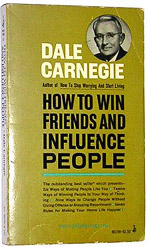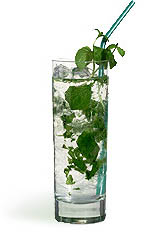
Once we bought books to help us meet interesting people. Now we join internet social networks.
I am not a liveblogger (yet), so my notes from SXSW 2006 are emerging only now, a week later. Over the next few days I’ll be gradually synthesizing my notes and posting a few thoughts about my experiences at SXSW.
First I want to talk about the most important part of SXSW, or any conference: The people you meet, the conversations you have, and the connections you make.
How to Win Friends and Influence People
This was my second year attending SXSW, and for me it was a lot better the second time around. The first time (last year) I only knew a handful of people — almost all of them exclusively virtually — so I often felt like the new kid at school.
But this year I arrived already knowing (or at least recognizing) a lot of people, so I was able to meet and talk to even more interesting people by virtue of having already-established social connections, people who were happy to continue extending the chain of introductions.
In fact, a major theme of the conference was the power of social networks, at least in the social software sense. In addition to the usual suspects who are always on the tips of people’s tongues, there were at least three four five different companies (Jambo, Plazes, Dodgeball, Meetro, and Loki) promoting products designed to help you find interesting people not just on the internet, but in your immediate physical vicinity… for example at a professional conference. Like little software versions of Dale Carnegie, these products promise a more fulfilling social life, better personal friendships, and more productive professional relationships.
But after shaking a hundred hands and hoisting almost as many glasses of beer, I began to wonder: How do these web-based tools stack up against tried and true methods of networking? Like having a mutual friend personally introduce two people who they think might get along with a hearty “Hey Chris, I want you to meet Hugh”? Or even the more straightforward technique of walking up to someone and simply saying “Hi, my name is Chris”?
My first thought is to suspect that while internet social networks are interesting and often useful communication tools, they ultimately cannot possibly improve the “quality” (that is, the psychological, emotional, intellectual,and professional value they add to one’s life) of one’s social network. Like internet dating services, they only take you a few steps closer to your objective: the majority of the journey, and the hardest parts, you must still take on your own. The tools help those who lack the connections or the chutzpah to pursue new relationships through traditional means, but they don’t always go all the way.
Still, I’d be a liar if I said that the internet doesn’t directly facilitate friendships. Five years ago I had maybe two or three friends who I originally met online… now I probably have dozens. I’d guess that the majority of the friendships between SXSW attendees had their origins online. Through blogs and blog comments, message boards, and email lists, most of us have genuine relationships with people we now consider real friends, even if we have never seen them face to face.

Mojitos
In my experience nothing beats a long sit-down-round-the-campfire discussion with a small group of really smart people and a steady supply of good booze.
My best example of real-life social networking at SXSW comes from Sunday night’s festivities, where a small group three of us grew organically over the course the evening into a 7-person ambulatory salon of nonstop stimulating conversation across at least four eating and drinking establishments, ending up at the Hilton Hotel bar slurping Mojitos until closing time and discussing a broad and constantly changing range of topics, both interactive-related and not. A welcome relief, I think, from the usual SXSW nighttime ritual of jumping around from one group of people to another at a noisy bar where conversations are nearly impossible.
Much respect to the whole mojito crew, in order of appearance: Khoi Vinh, Virginia Murdoch, Alissa Walker, Liz Danzico, John Gruber, and Michael Lopp.
Comments
One response to “SXSW Confidential, Part 1: Old School Social Networking”
It sounds like you had an excellent time. Dale is the man! You should also read Never Eat Alone by Keith Ferrazi and Tahl Raz. Its an excellent book that basically teaches you to be yourself in everything that you do.
Being a biz dev guy, I used to candy coat my pitches to new clients and often I would be victim of “corporate speak”. Since reading Never Eat Alone, I have implemented my own policy of always being real, never fake. It has done wonders for business and for my personal relationships. Everyone likes real Dan more than business Dan!
In the past two years I have become a big fan of business networks such as LinkedIn and Soflow. They are a great way to keep up with your contacts and also refer like-minded colleagues to others that may be able to help them out. Although I must stress that these online business networks are only useful if you back them up with tangible offline interaction. People need that face-to-face meeting to understand that you are genuine and not full of shit.